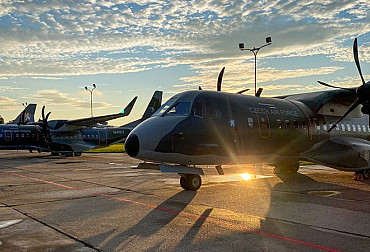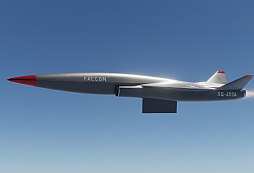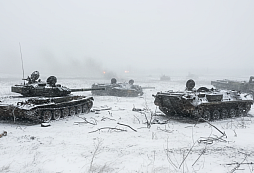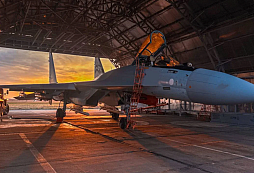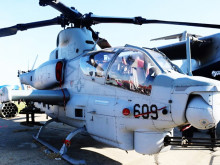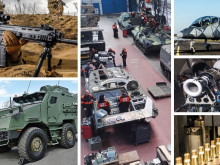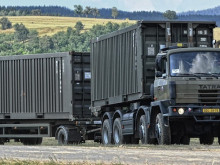Why we need new IFVs or lessons from Ukraine
At the end of June, the members of the Defence Committee received the promised opinion of the law firm HAVEL & PARTNERS s.r.o. regarding the tender for new IFVs for the Czech Armed Forces. In the summary of the main conclusions and recommendations of the legal assessment of the procedure of the contracting authority (the Ministry of Defence of the Czech Republic) in this strategic procurement project, it is stated that since the multi-round negotiation procedure is still ongoing, the legal assessment would jeopardize the ongoing decision-making process of the Ministry and therefore, according to the law firm, it is not possible to publish the full text of the legal assessment. According to the Minister of Defence, the main reason for the problems in the implementation of this tender is the number of bureaucratic processes that have lasted for more than 10 years.
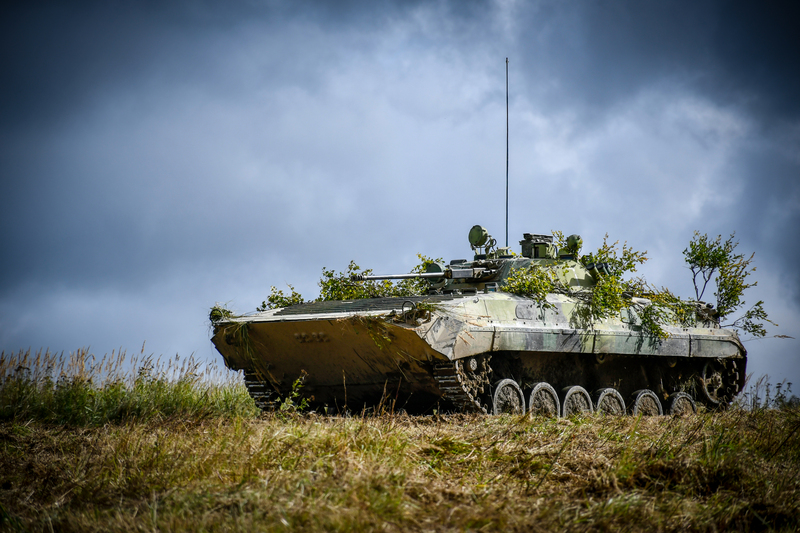 Picture: The Czech Armed Forces or the 7th Mechanized Brgiade currently uses the outdated BVP-2 (pictured), new IFVs are still pending. | mjr. Ladislav Kabát
Picture: The Czech Armed Forces or the 7th Mechanized Brgiade currently uses the outdated BVP-2 (pictured), new IFVs are still pending. | mjr. Ladislav Kabát
Recall that the current tender for new tracked IFVs has been dragging on since 2016 - and the obsolescence of the currently operating BVP-2s has been known for much longer. The conclusion of the tender process was supposed to happen during 2019, and deliveries of the new IFVs should have been in full swing by now. As things stand today, however, it is possible that the contract will not be concluded for several years, and the first new IFVs would not be delivered to our troops until sometime around 2026. And even this scenario can be described as optimistic, given other possible delays, reassessments or the current workload of the defense industry.
At present, it is clear that modern armies - including the Czech Armed Forces - need tracked IFVs. Indeed, the experience of the ongoing conflict in Ukraine suggests that modern tracked IFVs are de facto irreplaceable due to their capabilities.
Experience from Ukraine
The experience of deploying IFVs in Ukraine is extremely interesting. It is even more significant than the experience of deploying IFVs in the Armenia-Azerbaijan conflict in 2021, in which IFVs were deployed by both sides. Moreover, in both of the above conflicts, virtually the same types were deployed; the experience is therefore similar in many respects. In Ukraine, however, IFVs have been deployed in much larger numbers, offering us more basis for analysing their combat use.
In Ukraine, IFV types have been and are being deployed that are practically the same as the BVP-2 infantry fighting vehicles currently used by our Army, i.e. the Soviet BMP series vehicles. Both sides have deployed primarily the BMP-2 type, supplemented by the older BMP-1 type. It should be noted here that these were often upgraded units of these types. Russia deployed its BMP-2M vehicles equipped with the new Berezhok turret, Ukraine deployed its upgraded BMP-1UM types, etc. However, this does not change the fact that these are still typical BMP series vehicles, i.e. light BMPs, armed with the 2A42 30 mm calibre gun, or its lighter variant, the 2A72 gun, or in the case of the unmodernised BMP-1s, the 2A28 73 mm calibre low-pressure gun (plus ATGMs). Thus, these IFVs continued to suffer from their well-known shortcomings, especially weak armour, low level of mine protection and insufficient interior space. The Russian army then deployed in smaller numbers the more modern BMP-3 vehicles, armed with a combination of the 100 mm low-pressure gun and the 2A72 gun.
In Ukraine, IFVs are generally deployed in relatively small formations - usually no more than battalion size, often smaller. The IFVs have also been used in various encirclement or flanking operations, in which these vehicles were able to take full advantage of their capabilities, i.e. good mobility and traversability even over difficult terrain. Thus, they are not mechanically deployed in huge formations, as was envisaged, for example, during the Cold War (for which these vehicles were designed). The BVP-1 and BVP-2 vehicles are generally not deployed as intended when they were designed. I.e. to penetrate enemy defences in large mechanised and tank bundles, to conduct fire "from the firing range", etc. On the contrary, it is often seen from the various available footage how the swarm sits on the armour of the IFV, so as not to burn up inside in case of a hit. Modern Western IFVs were never conceived in their use as the Soviet Army, on whose requirements the BVP-1 and BVP-2 were built, envisaged for their IFVs.
It should also be noted that the Ukrainian terrain is ideal for IFVs. The same was the case during World War II, when the most extensive battles characterised by large-scale deployment of armoured vehicles took place in Ukraine. The experience in Ukraine is therefore quite different from the conflict between Armenia and Azerbaijan, where the fighting was fought in mountainous, very difficult and impenetrable terrain.
IFVs in Ukraine have also suffered a number of casualties - up to hundreds of vehicles on both sides, which unfortunately includes the loss of many lives. These losses are understandable given the large number of IFVs deployed and the intensity of the fighting and the high deployment of portable anti-tank weapons on both sides, yet the statistics regarding the number of IFVs destroyed are alarming, which can be a great lesson for the armies that still use IFVs (including the Czech Army).
The war in Ukraine has thus confirmed both the strengths and weaknesses of BMP vehicles. Once again, the biggest weakness of the BMP vehicles was their weak armour, which has been well known for a long time, but it was only in Ukraine that this problem was fully exposed. BMP vehicles proved to be unable to withstand modern anti-tank weapons, even lighter types such as the RPG-7 rocket-propelled grenades or the lighter single-shot RPG-18s. In a few cases, even during the initial phase of the war, BMP vehicles were destroyed by the old WWII-era PTRS anti-tank rifles, and the well-known ZU-23-2 light anti-aircraft guns also achieved some successes against BMPs.
Both sides have tried to address the problem of inadequate protection of BMP vehicles, primarily through the use of various additional armour. However, most of the time this is only a makeshift solution, which is usually not very successful. In some cases, lattice protection, which is also fitted to the BTR series Armoured Personnel Carriers, has also been used and has the ability to partially protect the vehicle from RPG attacks. However, even this solution is not optimal. A truly effective solution for IFV protection cannot be found, as the weak armour protection is inherent in the very design of these light vehicles (seaworthiness) and cannot be fitted with any suitably strong armour, as these vehicles simply would not be able to carry it.
The fighting in Ukraine has thus clearly demonstrated the importance of armour and therefore the correctness of the concept of Western, much better armoured, albeit on the other hand significantly heavier, IFV, such as the modern Puma, ASCOD, CV90 or Lynx KF41 BMP (i.e. also the IFVs offered in the Czech tender). Although it is questionable how far this increase in durability should go, and whether IFVs weighing up to 50 tonnes are really the right solution, it can be said that it was in the fighting in Ukraine that the importance of armour became apparent, especially for vehicles carrying infantry. Nevertheless, it must be taken into account that even the heavier armouring of Western equipment would probably have been ineffective against modern ATGMs.
On the other hand, the good features of BMP vehicles, namely their armament, were also evident in the fighting in Ukraine. In particular, BMP-2 vehicles armed primarily with the 2A42 cannon proved to be still a quality weapon whose performance (range, penetration) is sufficient against most targets. This is very important for the Czech Armed Forces. It turns out that the 30 mm calibre is still sufficient for the current IFVs, despite the fashionable trend of increasing the calibre of cannons, when the 35 mm or 40 mm calibre is used and types with 57 mm cannons are beginning to appear. But let's look at how many of these seemingly impressive projects have actually been implemented. The Western 30x173 mm ammunition, used for example in the Bushmaster cannon mounted on Czech Pandur vehicles, is even more powerful than the 30x165 ammunition used in the 2A42 cannon. However, if the Czech Armed Forces intend to use the cannon against drones, it would not be a bad idea to think about the 35 mm or 40 mm calibre with programmable ammunition, which is also true in the context of the planned replacement of weapon stations on the Pandur wheeled IFV. While the consequence of this decision would be a higher cost for ammunition, etc., the use of larger calibre and special ammunition would in turn result in lower consumption of ammunition for target elimination than would be the case with 30 mm ammunition.
Overall, the IFV as a category of military equipment has so far proved its worth in the fighting in Ukraine, which is important because the category of tracked BVP as such is sometimes questioned. Tracked IFV have demonstrated the capabilities expected of them, i.e. not only the ability to transport infantry, but also the ability to perform fire support and destroy a wide range of targets.
The IFV has thus proven to be a truly versatile weapon system. Their agility and wide manoeuvre capability are also highly appreciated. The main negative is the poor protection of BMP vehicles, which has led to such losses. Western IFVs would probably have fared much better in this situation, not only due to significantly stronger armour, but also due to more advanced sensor equipment capable of detecting an adversary in time. Another problem for both the Ukrainian and Russian armies is the lack of deployment of modern tracked IFVs, which is somewhat paradoxical given that the arms industries of these countries have already managed to develop such vehicles as the BMPV-64 in the case of Ukraine or the Kurganets-25 in the case of Russia, the development of which has not yet been completed.
Lessons from Ukraine for the Czech Republic
First of all, the events in Ukraine clearly point to the need to fundamentally strengthen the Czech Republic's defence capability, and therefore also the Czech Armed Forces. This is for the simple reason that the Czech Republic is clearly not free from direct threats. The fact that a military conflict - and a conflict of such scale and intensity at that - has broken out so close to the Czech Republic means that it may affect us directly. If anyone continues to believe that there is no direct danger to the Czech Republic, then it is again the experience of Ukraine that can be pointed to. As recently as 2010, despite the experience of the Russian-Georgian war, it was still common to find opinions in the Ukrainian specialist military press that Ukraine was not in danger of something similar, that the country would never be attacked by Russia in an open military conflict. Similarly, in the Russian military press there were opinions that Russia would never threaten Ukraine because Russians and Ukrainians are brotherly nations, etc. It has only taken a few years and everything is completely different. The aggressive style of Russian foreign policy is simply a force to be reckoned with, and it is very questionable whether the eventual departure of V. Putin's retirement.
It is clear that the strengthening of the defence capability of the Czech Army can be achieved, among other things, by means of tracked IFVs. Indeed, the fighting in Ukraine has clearly demonstrated the importance of these infantry fighting vehicles, where even the now obsolete BMP was able to do a lot of work. This is even more true in the case of Western, better armoured IFVs equipped with modern software.
Similarly, the Ukraine has seen a certain irreplaceability of tracked IFVs by other types, such as wheeled armoured personnel carriers or other armoured vehicles, especially MRAP/MRAV vehicles. Such vehicles are certainly also needed in the army, but for different purposes and in different combat situations. Wheeled armoured vehicles can, in various modifications, suitably complement tracked IFVs, but cannot completely replace their capabilities. It is thus obvious that the Czech Republic, or rather the Czech Armed Forces, really needs modern tracked armoured vehicles. The question then is how to deal with the current tender for new IFVs or how to organise a new tender.
What to do now with the tender for new IFVs
At present, the Ministry of Defence has had for some time the opinion of the law firm HAVEL & PARTNERS s.r.o., which has legally assessed the public contract "Tracked Infantry Fighting Vehicle and its modifications - purchase" at the request of the Ministry and now the Ministry is deciding on the further course of action. "All the companies that applied for the tender have already invested considerable funds, in the order of tens to hundreds of millions of crowns, and if we make the wrong decision at this current imaginary crossroads, it could cost the Czech Republic a lot of money in arbitrations," Defence Minister Jana Černochová said some time ago. So everything needs to be carefully considered, but on the other hand it is important that this situation is resolved as soon as possible, not only so that our soldiers know where they stand, but also because of the ever-increasing inflation, rising prices for materials and services, and the ever-increasing workload of arms companies.
It is now clear that the 210 IFVs will not be able to be acquired for the originally planned CZK 53 billion. Now they are talking about a price of more than CZK 60 billion or rather CZK 70 billion. The question then is whether it would not be possible to achieve a reduction in the price by, for example, reducing the original number of tracked infantry fighting vehicles ordered or supplementing these vehicles with support vehicles on wheeled platforms.
It is perfectly logical to continue the effort to procure new tracked IFVs for the Czech Armed Forces - whether in the current tender or in a new tender - despite the high purchase price. The price can then be worked with. For example, one can try to negotiate a spread of payments over a longer period of time, where it is assumed that the budget of the Czech Army will be significantly strengthened in the coming years, as the current government wants to increase defence spending to the required 2% of GDP (by 2024).
The acquisition of the new tracked IFVs fully fits into the structure of the Army, and only thanks to them the Army forms a compact whole, and the bon mot "without a heavy brigade there is no army" is thus completely appropriate. At present, the Czech Army is finally starting to modernize its so-called heavy equipment, with new weapon systems such as the new CAESAR self-propelled guns or new tanks (the Leopard 2 A7+ tank is the favourite so far). It would be nonsensical for the Czech Army to have modern tanks and self-propelled guns while still using old, worn-out BVP-2s. Modern armed forces resemble a wall in many ways. If the wall is compact, if all of its components form a continuous line, then the wall stands fine. However, if one part is significantly weaker than the others, then not only the weak part but the whole wall may collapse when the wind blows.
However, despite the current suspension of the acquisition of IFVs, some preparation for the arrival of new tracked IFVs can already be made. For example, the question of ammunition for the cannon of the new IFV can already be addressed. If an IFV with a 30 mm cannon is introduced (which everything indicates at present, and it is the 30 mm calibre that is mentioned in the requirements of the Army), and of whatever type, it is obvious that the Army will need a huge amount of ammunition of that calibre. In addition, the Czech Army also needs this ammunition for its Pandur vehicles, the number of which is to be increased in the future. It would be great if the Czech Republic were able to produce this ammunition itself, and in appropriate quantities.
In conclusion, despite all the delays so far, and despite the fact that the tender for the new IFVs has dragged on for so long, it makes sense to continue the effort to acquire new IFVs for the Czech Army. This is not only because of our commitments to our allies, but above all because of ourselves, because of our security, which is clearly confirmed by the current situation in Ukraine.
















